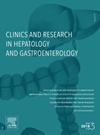Chronic kidney disease in isolated core antibody positive hepatitis B patients: Risk analysis from NHANES 2017–2020 study
IF 2.4
4区 医学
Q2 GASTROENTEROLOGY & HEPATOLOGY
Clinics and research in hepatology and gastroenterology
Pub Date : 2025-05-27
DOI:10.1016/j.clinre.2025.102627
引用次数: 0
Abstract
Background
The association between isolated hepatitis B core antibody (HBcAb) positivity and chronic kidney disease (CKD) remains debated. While some studies suggest HBV infection increases CKD risk, others report inconclusive findings. This study evaluated the association between isolated HBcAb positivityand CKD in the U.S. population.
Methods
Data from adult participants in the NHANES 2017–2020 pre-pandemic cycle were analyzed based on prespecified eligibility criteria. Participants were categorized into isolated HBcAb positive and non-infected groups. Weighted means and percentages described participant characteristics, while logistic regression models evaluated the association between isolated HBcAb positive and CKD. Multivariate logistic regression identified CKD risk factors among isolated HBcAb positive individuals.
Results
Among 7,582 participants (7072 non- infected and 510 isolated HBcAb positive), CKD prevalence was higher in isolated HBcAb positive individuals (7.9 %vs. 5.2 %, P = 0.018). Unadjusted analyses showed isolated HBcAb positivity increased CKD risk (OR = 1.25, 95 % CI: 1.04–1.50, P = 0.019). However, adjusted analyses revealed an inverse association (OR = 0.76, 95 % CI: 0.60–0.98, P = 0.034). In isolated HBcAb positive individuals, older age (OR = 1.06, P = 0.017) and serum urea nitrogen (BUN) elevation (OR = 1.20, P = 0.001) were associated with higher CKD risk, while higher education lever reduced the risk (OR = 0.28, P = 0.030).
Conclusion
Although CKD prevalence was higher in isolated HBcAb positive patients, There was no positive association between isolated HBcAb positivity and CKD. Older age and elevated BUN levels were significantly associated with higher CKD risk, while elevated education lever reduced the risk. These findings highlight the needs for individualized monitoring and management of at-risk HBV-infected patients when offering antiviral therapy and monitoring after clinical cure of hepatitis B.
分离的核心抗体阳性乙型肝炎患者的慢性肾脏疾病:NHANES 2017-2020研究的风险分析:HBV感染和CKD风险
背景:分离的乙型肝炎核心抗体(HBcAb)阳性与慢性肾脏疾病(CKD)之间的关系仍存在争议。虽然一些研究表明HBV感染增加CKD风险,但其他研究报告的结果不确定。本研究评估了美国人群中分离HBcAb阳性与CKD之间的关系:方法:根据预先指定的资格标准,分析了NHANES 2017-2020大流行前周期的成年参与者的数据。参与者被分为分离的HBcAb阳性组和未感染组。加权平均值和百分比描述了参与者的特征,而逻辑回归模型评估了分离HBcAb阳性与CKD之间的关系。多因素logistic回归在分离HBcAb阳性个体中确定CKD危险因素。结果:在7582名参与者中(7072名未感染和510名分离HBcAb阳性),CKD患病率在分离HBcAb阳性个体中较高(7.9% vs. 5.2%, P = 0.018)。未经调整的分析显示,孤立HBcAb阳性增加CKD风险(OR = 1.25,95% CI: 1.04-1.50, P = 0.019)。然而,调整后的分析显示两者呈负相关(OR = 0.76,95% CI: 0.60-0.98, P = 0.034)。在孤立HBcAb积极的个人,年龄(或 = 1.06,P = 0.017)和血清尿素氮(BUN)测定高程(或 = 1.20,P = 0.001)与慢性肾病风险较高,而高等教育杠杆降低风险(或 = 0.28,P = 0.030)。结论:虽然分离HBcAb阳性患者的CKD患病率较高,但分离HBcAb阳性与CKD之间没有正相关关系。年龄较大和BUN水平升高与CKD风险升高显著相关,而教育水平升高可降低风险。这些发现强调了在提供抗病毒治疗和乙型肝炎临床治愈后进行监测时,对高危hbv感染患者进行个性化监测和管理的必要性。
本文章由计算机程序翻译,如有差异,请以英文原文为准。
求助全文
约1分钟内获得全文
求助全文
来源期刊

Clinics and research in hepatology and gastroenterology
GASTROENTEROLOGY & HEPATOLOGY-
CiteScore
4.30
自引率
3.70%
发文量
198
审稿时长
42 days
期刊介绍:
Clinics and Research in Hepatology and Gastroenterology publishes high-quality original research papers in the field of hepatology and gastroenterology. The editors put the accent on rapid communication of new research and clinical developments and so called "hot topic" issues. Following a clear Editorial line, besides original articles and case reports, each issue features editorials, commentaries and reviews. The journal encourages research and discussion between all those involved in the specialty on an international level. All articles are peer reviewed by international experts, the articles in press are online and indexed in the international databases (Current Contents, Pubmed, Scopus, Science Direct).
Clinics and Research in Hepatology and Gastroenterology is a subscription journal (with optional open access), which allows you to publish your research without any cost to you (unless you proactively chose the open access option). Your article will be available to all researchers around the globe whose institution has a subscription to the journal.
 求助内容:
求助内容: 应助结果提醒方式:
应助结果提醒方式:


